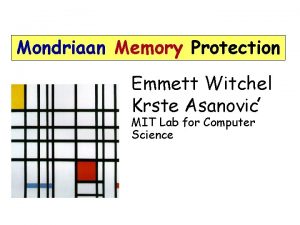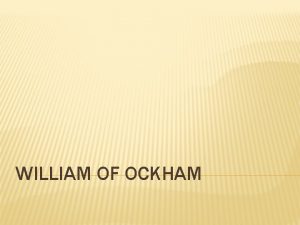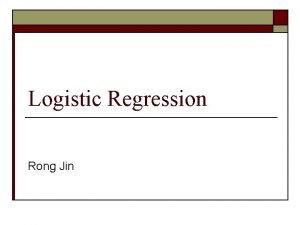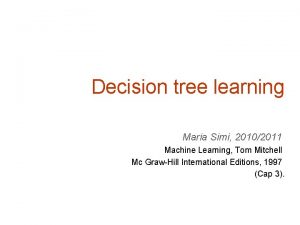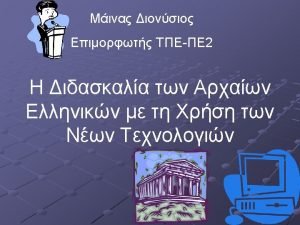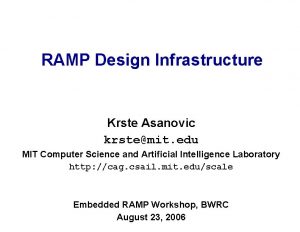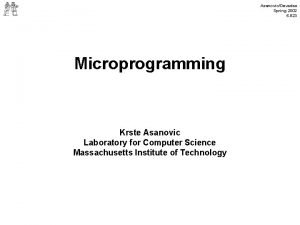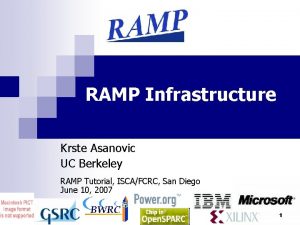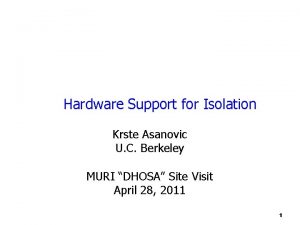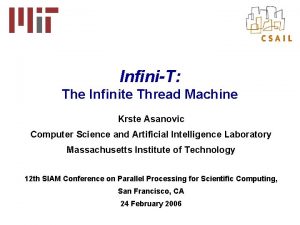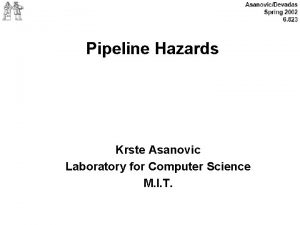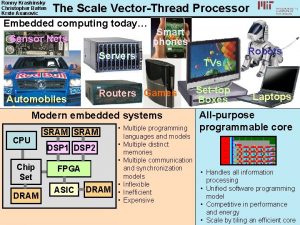Occam and Transputers Krste Asanovic krstelcs mit edu











- Slides: 11

Occam and Transputers Krste Asanovic krste@lcs. mit. edu http: //www. cag. lcs. mit. edu/6. 893 -f 2000/ 1

Occam: An Explicitly Parallel Language n Occam based on Communicating Sequential Processes (CSP) formalism developed by Tony Hoare, Oxford, UK, and an experimental language by David May, Bristol, UK n Designed to have a formal semantics suitable for automatic program transformations n Many groups investigated direct translation of Occam into hardware 2

Transputers n The transputer architecture was designed as an Occam engine o Transputer C compiler didn’t appear until much later, and initially produced inferior code compared with Occam compiler n Original target for transputer was embedded control (robots) where interfacing to hardware directly was important n Designed to allow large arrays of transputers to be connected easily n Almost no glue logic required for minimal transputer node 3

Occam Basics n Occam primitive is a process, five kinds: o Assignment x : = y + 2 keyboard ? char screen ! Char SKIP -- NOP that terminates STOP –- NOP that never terminates o Input o Output o Skip o Stop n Channels provide communication between processes o Unbuffered, point-to-point synchronous communication o Channels have declared protocol types c ! x Channel c c ? y 4

Composing Sequential Processes n SEQ executes sub-processes sequentially SEQ keyboard ? char –- read char from keyboard screen ! char -- write char to screen n Can do replicated SEQ i = 0 FOR array. size stream ! data. array[i] -- equivalent to SEQ stream ! data. array[0] stream ! data. array[1]. . . 5

Composing Parallel Processes n PAR executes sub-processes in parallel PAR keyboard(kbd. to. ed) editor(kbd. to. ed, ed. to. screen) screen(ed. to. screen) ed. to. screen kbd. to. ed keyboard editor 6

PAR for parallel execution WHILE next <> EOF SEQ x : = next PAR in ? next out ! x * x Restrictions on parallel data access o variables modified in one arm of PAR cannot be read or written in other parts of PAR, e. g. , PAR -- this PAR is invalid SEQ mice : = 42 -- assigns to mice c ! 42 c ? mice -- assigns to mice 7

Replicated PAR n Can use replicated PAR to build array of parallel processes PAR farmer() PAR i = 0 FOR 4 -- count must be constant worker(i) farmer() array of channels used to connect processes (not shown in code snippet) worker(0) worker(1) worker(2) worker(3) 8

Alternation n ALT combines a number of processes only one of which is executed n Each process has a guard: input on channel o wait on timer o can be predicated with boolean expression ALT o left ? packet -- guard input statement stream ! packet right ? packet –- guard input statement stream ! packet left right n ALT stream PRI ALT prioritizes sub-processes in textual order 9

Channel Protocols n All channels have set of legal message types, the channel protocol. Compiler checks all uses of channels to ensure all communications are compatible with type of channel. o CHAN OF [36]BYTE message : -- explicit array type o CHAN OF COMPLEX 32 imp : -- named record (struct) o CHAN OF INT: : []BYTE link: -- length + vector o message ! “Hello, World!” o link ! len: : [buffer FROM start] n Also supports tagged type channels, and sequential message channels n Goal is type-safe communication 10

Configuration n Occam application written as network of communicating processes n Configuration step maps parallel process components onto available physical processors and maps channels to hardware links n Configuration should not change correctness 11

